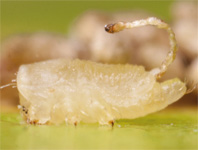Abstract
Recent expeditions exploring deep-sea hydrothermal vent ecosystems in the Okinawa Trough, East China Sea resulted in the collection of a hitherto undescribed species of polyplacophoran mollusc found living at three different vent fields at depths of 950–1178 m. This new chiton is a member of the small lepidopleuran family Protochitonidae and is morphologically similar to Hanleyella japonica Saito, 1997. The two species differ in small morphological differences of the valve shape and elevation, are divergent in the standard molecular barcoding mitochondrial gene cytochrome oxidase I (COI), and furthermore the known distribution range of H. japonica is considerably more northern and also shallower. The new species is described herein as Hanleyella henrici n. sp. Additional in situ observations taken in the course of collecting material for this study indicates that chitons are more abundant in the vicinity of hydrothermal vents than was previously appreciated, and perhaps more speciose.
References
Ashby, E. (1925) Monograph on Australian fossil Polyplacophora (Chitons). Proceedings of the Royal Society of Victoria, 37, 170–205.
Chen, C., Ogura, T., Hirayama, H., Watanabe, H.K., Miyazaki, J. & Okutani, T. (2016) First seep-dwelling Desbruyeresia (Gastropoda: Abyssochrysoidea) species discovered from a serpentinite-hosted seep in the Southeastern Mariana Forearc. Molluscan Research, 36, 277–284.
https://doi.org/10.1080/13235818.2016.1172547Chen, C., Watanabe, H.K., Miyazaki, J. & Kawagucci, S. (2017) Unanticipated discovery of two rare gastropod molluscs from recently located hydrothermally influenced areas in the Okinawa Trough. PeerJ, 5, e4121.
https://doi.org/10.7717/peerj.4121Chen, C., Chan, T.-Y. & Chan, B.K.K. (2018) Molluscan diversity in shallow water hydrothermal vents off Kueishan Island, Taiwan. Marine Biodiversity, 48, 709–714.
https://doi.org/10.1007/s12526-017-0804-2Desbruyères, D., Segonzac, M. & Bright, M. (2006) Handbook of deep-sea hydrothermal vent fauna (2nd ed.). Oberösterreichische Landesmuseen, Linz, 544 pp.
Folmer, O., Black, M., Hoeh, W., Lutz, R. & Vrijenhoek, R. (1994) DNA primers for amplification of mitochondrial cytochrome c oxidase subunit I from diverse metazoan invertebrates. Molecular Marine Biology and Biotechnology, 3, 294–299.
Gray, J.E. (1821) A natural arrangement of Mollusca according to their internal structure. London Medical Repository, 15, 221–239.
Kojima, S. & Ohta, S. (1997) Calyptogena okutanii n. sp., a sibling species of Calyptogena soyoae Okutani, 1957 (Bivalvia: Vesicomyidae). Venus, 56, 189–195.
Kumar, S., Stecher, G., Li, M., Knyaz, C. & Tamura, K. (2018) MEGA X: Molecular Evolutionary Genetics Analysis across computing platforms. Molecular Biology and Evolution, 35, 1547–1549.
https://doi.org/10.1093/molbev/msy096Kuroda, T. (1943) Akebiconcha, a new pelecypod genus. Venus, 13, 14–18.
Miyazaki, J., Kawagucci, S., Makabe, A., Takahashi, A., Kitada, K., Torimoto, J., Matsui, Y., Tasumi, E., Shibuya, T., Nakamura, K., Horai, S., Sato, S., Ishibashi, J.-I., Kanzaki, H., Nakagawa, S., Hirai, M., Takaki, Y., Okino, K., Watanabe, H.K., Kumagai, H. & Chen, C. (2017) Deepest and hottest hydrothermal activity in the Okinawa Trough: the Yokosuka site at Yaeyama Knoll. Royal Society Open Science, 4, 171570.
https://doi.org/10.1098/rsos.171570Nakamura, K., Kawagucci, S., Kitada, K., Kumagai, H., Takai, K. & Okino, K. (2015) Water column imaging with multibeam echo-sounding in the mid-Okinawa Trough: Implications for distribution of deep-sea hydrothermal vent sites and the cause of acoustic water column anomaly. Geochemical Journal, 49, 579–596.
https://doi.org/10.2343/geochemj.2.0387Saito, H. (1997) Deep-sea chiton fauna of Suruga Bay (Mollusca: Polyplacophora) with descriptions of six new species. National Science Museum Monographs, 12, 31–58.
Saito, H. (2011) Chitons (Mollusca: Polyplacophora) from submarine banks off Izu Islands and Bōsō Peninsula, Japan. Memoirs of the National Museum of Nature and Science, Tokyo, 47, 65–81.
Saito, H. (2013) A new species of Lepidozona (Mollusca, Polyplacophora, Ischnochitonidae) from Okinawa Trough, East China Sea. Bulletin of the National Museum of Nature and Science, Series A, 39, 5–10.
Saito, H., Fujikura, K. & Tsuchida, S. (2008) Chitons (Mollusca: Polyplacophora) associated with hydrothermal vents and methane seeps around Japan, with descriptions of three new species. American Mallacological Bulletin, 25, 113–124.
https://doi.org/10.4003/0740-2783-25.1.113Saito, H. & Okutani, T. (1990) Two new chitons (Mollusca: Polyplacophora) from a hydrothermal vent site of the Iheya Small Ridge, Okinawa Trough, East China Sea. Venus (Japanese Journal of Malacology), 49, 165–179.
Sasaki, T., Warén, A., Kano, Y., Okutani, T., Fujikura, K. & Kiel, S. (2010) Gastropods from recent hot vents and cold seeps: systematics, diversity and life strategies. In: Kiel, S. (Ed.), The Vent and Seep Biota. Topics in Geobiology, 33, pp. 169–254.
https://doi.org/10.1007/978-90-481-9572-5_7Schwabe, E., Forsterra, G., Haussermann, V., Melzer, R.R. & Schrödl, M. (2006) Chitons (Mollusca: Polyplacophora) from the southern Chilean Comau Fjord, with reinstatement of Tonicia calbucensis Plate, 1897. Zootaxa, 1341, 1–27.
Sigwart, J.D., Schwabe, E., Saito, H., Samadi, S. & Giribert, G. (2011) Evolution in the deep sea: a combined analysis of the earliest diverging living chitons (Mollusca: Polyplacophora: Lepidopleurida). Invertebrate Systematics, 24, 560–572.
Sigwart, J.D., Sumner-Rooney, L.H., Schwabe, E., Heß, M., Brennan, G.P. & Schrödl, M. (2014) A new sensory organ in “primitive” molluscs (Polyplacophora: Lepidopleurida), and its context in the nervous system of chitons. Frontiers in Zoology, 11, 7.
https://doi.org/10.1186/1742-9994-11-7Sirenko, B.I. (1973) A new genus of the family Lepidopleuridae (Neoloricata). Zoologicheskii Zhurnal, 52, 1569–1571.
Sirenko, B. (2018) Taiwanese deep-water chitons (Mollusca: Polyplacophora) and survey of chiton fauna of Taiwan. Zootaxa, 4422 (3), 301–344.
https://doi.org/10.11646/zootaxa.4422.3.1Thiele, J. (1909) Revision des systems der chitonen, part I. Zoologica Stuttgart, 22, 1–70.
Trager, G.C. & DeNiro, M.J. (1990) Chemoautotrophic sulfur bacteria as a food source for mollusks at intertidal hydrothermal vents: evidence from stable isotopes. The Veliger, 33, 359–362

